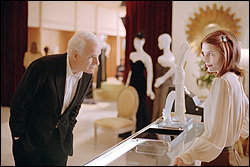Mirabelle Buttersfield, c’est moi. I’m not really sure if Steve Martin feels that way about his Shopgirl (which opens Friday, Oct. 28, at the Meridian and Seven Gables). She was first a character in his 2000 novella of the same name, now she’s played by Claire Danes in the movie, and she was originally the writer/actor’s girlfriend during the ’90s: Allyson Hollingsworth, an artist now living in the Bay Area. Martin dedicated the book to her, and the artworks created by Mirabelle in the film are actually Hollingsworth’s. Has he purchased her consent to fictionalize her life on page and screen? I don’t think so. Shopgirl is an imperfect but loving look at imperfectly loving people; it is also generous and more than a little sad. The role of Mirabelle is a gem, and it is cut to melancholy perfection by Danes—high tribute, indeed, to the woman who inspired it. Martin gives himself the considerably lesser role of Ray Porter, a rich, older man with profound emotional limits; he is a guy destined to be lonely and deserving of his fate. (Martin also narrates from a different, omniscient perspective.)
Mirabelle stands daily poised like a mannequin behind the untrafficked glove counter at a Los Angeles department store. They probably dust it every day, but still it’s dusty. At home, she lives with a cat named Sylvia (Plath?) and occasionally takes photos of herself in empty nighttime parks, illuminated by the lights of her pickup (still with her native Vermont plates). She later transforms the photos into sketches with a doomy, charcoal, memorial vibe— documents almost from another, older era. A slacker named Jeremy (Jason Schwartzman) meets her in a laundromat, they have an awkward little thing, and she goes back to her antidepressant-stabilized routine, dressed in her out-of-time fashions, like a woman in a Dorothea Lange photograph. Maybe it’s that isolation that draws Ray to her: He lives in a practically empty hillside house when he’s in L.A.; otherwise he jets by private plane back and forth to Seattle, where he’s some kind of software baron. (A “symbolic logician” is how he describes his trade; women of Seattle, avoid this phrase like the plague in the online personals.)
Jeremy is no match for Ray. His goal is to be a roadie, not a symbolic logician, and he disappears for most of Shopgirl to tend the amps of a touring band (led by the Red House Painters’ Mark Kozelek). He comes back transformed, and this transformation betrays the same extensive re-editing that mars the movie. Martin had a long time to make Shopgirl, and he hired a respectable director (Hilary and Jackie‘s Anand Tucker) to help. But the final product shows considerable indecision and second-guessing. The casualties include not just Jeremy’s makeover, but Mirabelle’s parents (Frances Conroy and Timothy Bottoms), her jealous and slutty blond co-worker (Bridgette Wilson-Sampras), and a lot of connective scenes.
As a result, Shopgirl doesn’t feel quite finished, as if Martin still hasn’t resolved his feelings about the movie. (Never mind his relationship with Hollingsworth.) Which gives the movie its muted force, however: How many of us ever resolve our feelings about a past love? You know from the start that Ray and Mirabelle can’t last; they’re too far apart in age and experience. What you couldn’t predict is how that mismatch will be both damaging and mending.
Some history: Martin has regularly whored out his genial talents by acting in Cheaper by the Dozen, Bringing Down the House, Sgt. Bilko, and a lot of like dreck (all of it quite profitable). But as a writer, he’s responsible for Roxanne, L.A. Story, and Bowfinger. There’s bad Martin and there’s good Martin, and Shopgirl comes from the latter display case, created for his New Yorker–reading clientele. It really isn’t even a comedy, though Schwartzman’s scenes are amusing, and Martin pokes fun at Ray’s unfamiliarity with bad wine and uncomfortably low futon couches. Martin’s real focus—and it’s a bit of a shock to be writing this in the context of today’s movies, when Doom just came out—is the inner life of a young woman.
Mirabelle is “stranded in the vast openness of Los Angeles,” says the narrator. It’s not enough for her to be rescued by a knight on horseback, and Martin looks more like Prince Charming’s dad, anyway. When she thinks she’s found love with Ray, whose manners and money are at first thrilling, she decides to go off her meds, resulting in a UD scene—an underdose. Her problem is that she feels too much and does too little. She’s a photograph that hasn’t yet emulsified into its latent image.
Nobody needs to be told that Danes is a fine young actress, and Martin allows her to work slowly and deliberately—like Mirabelle’s own artistic methods. (Ray asks her how many paintings she makes, and the answer is about two or three per year.) Mirabelle, too, is a work in very gradual progress; Shopgirl is remarkably unhurried for a studio film, and perhaps this is the benefit of stretching out a small book as opposed to cramming a big one into a movie.
However, Martin doesn’t quite succeed in proving how his characters are all “connected without even knowing it.” Ray’s mansion looks down on Silver Lake; from there, Mirabelle can spy on Jeremy, who’s later mistaken for Ray by Wilson-Sampras’ man stealer. Shopgirl isn’t so satisfyingly interplotted as his L.A. Story; it’s smaller and more hermetic than that, and Martin will have to pay for its limited appeal with the dreaded and even longer-delayed Pink Panther redo (expected next February), when he’ll walk in Peter Sellers’ shoes. Good luck.
I won’t pretend to understand Martin’s Hollywood choices, nor will I conjecture anything about the relationship that inspired Shopgirl. But on film, at least, he knows how to treat a lady.








